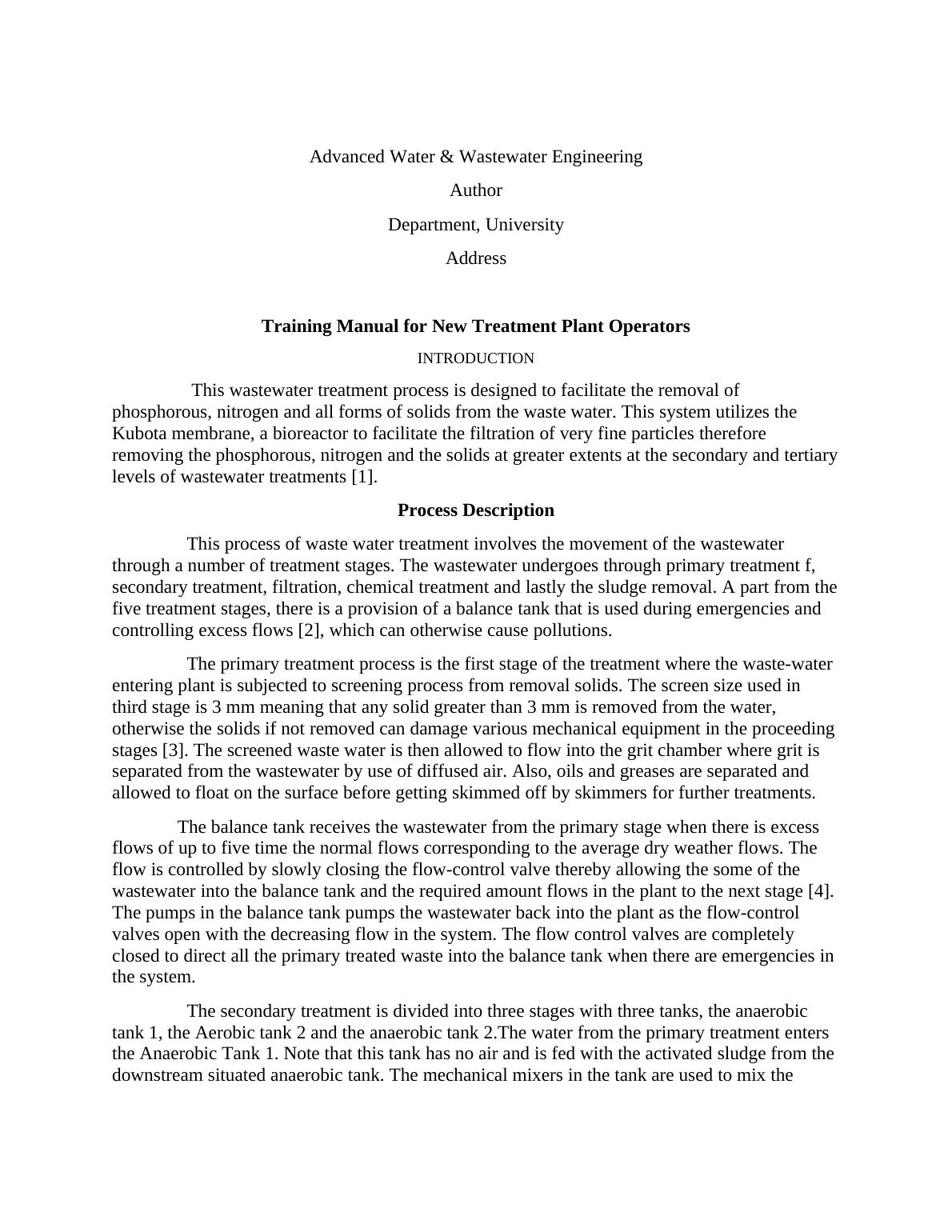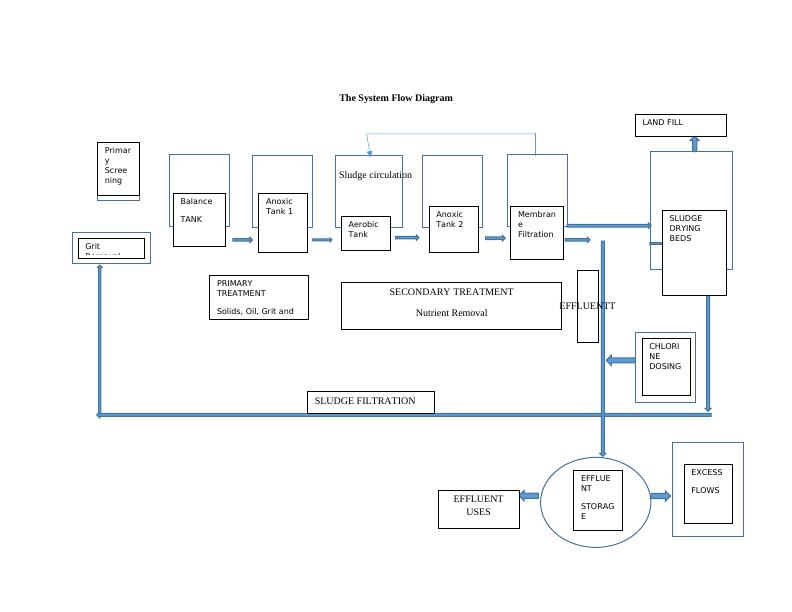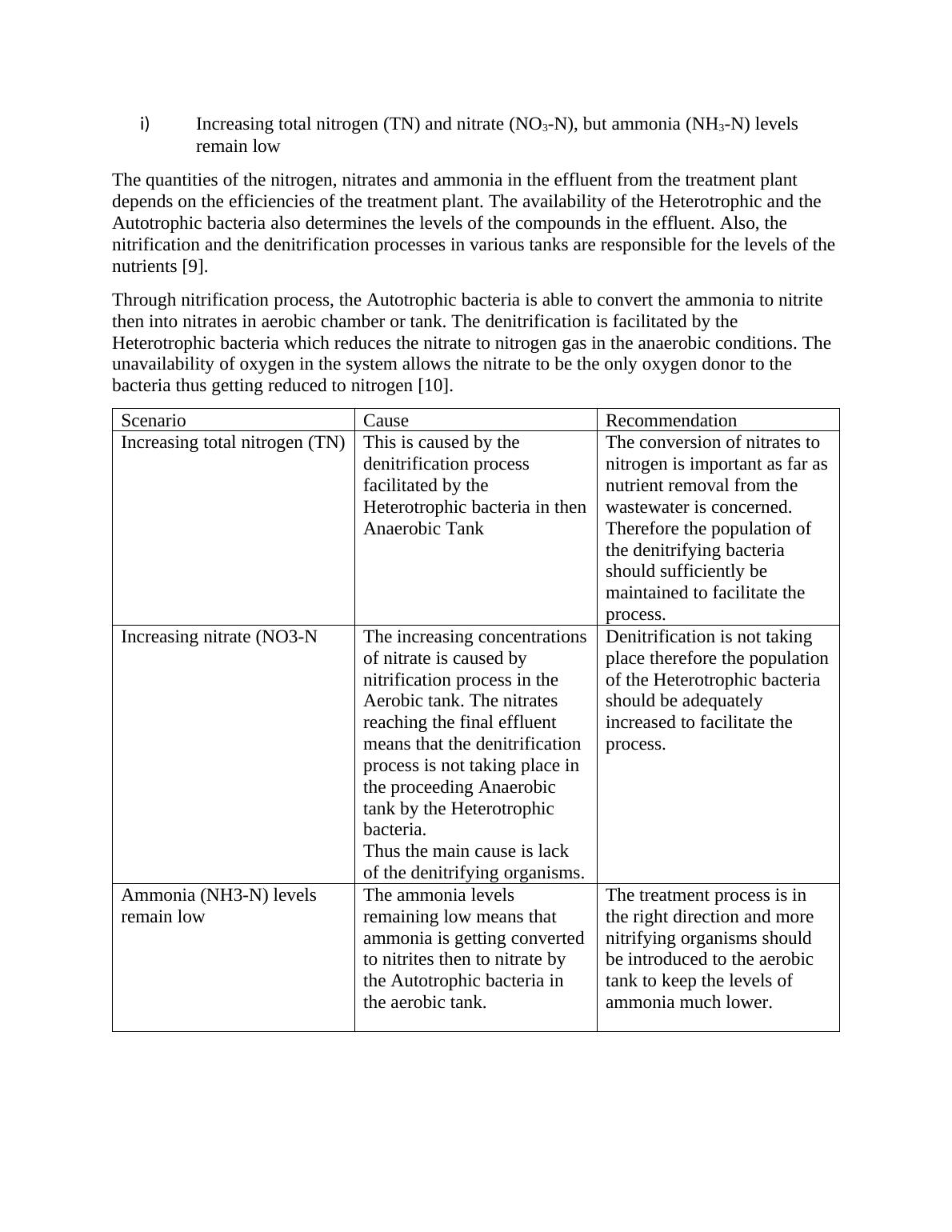Advanced Water & Wastewater Engineering Case Study 2022
Added on 2022-10-04
13 Pages4556 Words28 Views
Advanced Water & Wastewater Engineering
Author
Department, University
Address
Training Manual for New Treatment Plant Operators
INTRODUCTION
This wastewater treatment process is designed to facilitate the removal of
phosphorous, nitrogen and all forms of solids from the waste water. This system utilizes the
Kubota membrane, a bioreactor to facilitate the filtration of very fine particles therefore
removing the phosphorous, nitrogen and the solids at greater extents at the secondary and tertiary
levels of wastewater treatments [1].
Process Description
This process of waste water treatment involves the movement of the wastewater
through a number of treatment stages. The wastewater undergoes through primary treatment f,
secondary treatment, filtration, chemical treatment and lastly the sludge removal. A part from the
five treatment stages, there is a provision of a balance tank that is used during emergencies and
controlling excess flows [2], which can otherwise cause pollutions.
The primary treatment process is the first stage of the treatment where the waste-water
entering plant is subjected to screening process from removal solids. The screen size used in
third stage is 3 mm meaning that any solid greater than 3 mm is removed from the water,
otherwise the solids if not removed can damage various mechanical equipment in the proceeding
stages [3]. The screened waste water is then allowed to flow into the grit chamber where grit is
separated from the wastewater by use of diffused air. Also, oils and greases are separated and
allowed to float on the surface before getting skimmed off by skimmers for further treatments.
The balance tank receives the wastewater from the primary stage when there is excess
flows of up to five time the normal flows corresponding to the average dry weather flows. The
flow is controlled by slowly closing the flow-control valve thereby allowing the some of the
wastewater into the balance tank and the required amount flows in the plant to the next stage [4].
The pumps in the balance tank pumps the wastewater back into the plant as the flow-control
valves open with the decreasing flow in the system. The flow control valves are completely
closed to direct all the primary treated waste into the balance tank when there are emergencies in
the system.
The secondary treatment is divided into three stages with three tanks, the anaerobic
tank 1, the Aerobic tank 2 and the anaerobic tank 2.The water from the primary treatment enters
the Anaerobic Tank 1. Note that this tank has no air and is fed with the activated sludge from the
downstream situated anaerobic tank. The mechanical mixers in the tank are used to mix the
Author
Department, University
Address
Training Manual for New Treatment Plant Operators
INTRODUCTION
This wastewater treatment process is designed to facilitate the removal of
phosphorous, nitrogen and all forms of solids from the waste water. This system utilizes the
Kubota membrane, a bioreactor to facilitate the filtration of very fine particles therefore
removing the phosphorous, nitrogen and the solids at greater extents at the secondary and tertiary
levels of wastewater treatments [1].
Process Description
This process of waste water treatment involves the movement of the wastewater
through a number of treatment stages. The wastewater undergoes through primary treatment f,
secondary treatment, filtration, chemical treatment and lastly the sludge removal. A part from the
five treatment stages, there is a provision of a balance tank that is used during emergencies and
controlling excess flows [2], which can otherwise cause pollutions.
The primary treatment process is the first stage of the treatment where the waste-water
entering plant is subjected to screening process from removal solids. The screen size used in
third stage is 3 mm meaning that any solid greater than 3 mm is removed from the water,
otherwise the solids if not removed can damage various mechanical equipment in the proceeding
stages [3]. The screened waste water is then allowed to flow into the grit chamber where grit is
separated from the wastewater by use of diffused air. Also, oils and greases are separated and
allowed to float on the surface before getting skimmed off by skimmers for further treatments.
The balance tank receives the wastewater from the primary stage when there is excess
flows of up to five time the normal flows corresponding to the average dry weather flows. The
flow is controlled by slowly closing the flow-control valve thereby allowing the some of the
wastewater into the balance tank and the required amount flows in the plant to the next stage [4].
The pumps in the balance tank pumps the wastewater back into the plant as the flow-control
valves open with the decreasing flow in the system. The flow control valves are completely
closed to direct all the primary treated waste into the balance tank when there are emergencies in
the system.
The secondary treatment is divided into three stages with three tanks, the anaerobic
tank 1, the Aerobic tank 2 and the anaerobic tank 2.The water from the primary treatment enters
the Anaerobic Tank 1. Note that this tank has no air and is fed with the activated sludge from the
downstream situated anaerobic tank. The mechanical mixers in the tank are used to mix the

wastewater continuously in the tank leading to the breakdown of nitrates when oxygen is utilized
in the production of Autotrophic bacteria thus reducing the level of nutrients in the waste water.
The sludge from Tank 1 is allowed to flow into the Aerobic Tank 2 and supplied
with dissolved oxygen through the computer controlled variable frequency drive blowers. The
reactions by the heterotrophic bacteria take place in this tank to remove other compounds like
phosphorous and ammonia from the wastewater [5]. Aluminium sulphate is also introduced in
this tank to remove any excess phosphorous [6] and acoustic dosing done to increase the low pH
[7] of the wastewater. Micro-organisms such as the protozoa are also introduced into the tank to
consume the bacteria this leaving a relatively cleaner wastewater. From the aerobic tank 2, the
sludge is directed into the anoxic tank 2 where the nitrate and nitrogen levels in the wastewater
are considerably reduced. The denitrification process is achieved through the autotrophic bacteria
in the tank where the nitrate is reduced to nitrogen by the bacteria.
The last process in the wastewater treatment is the filtration of the sludge through the
submerged membrane filtration. The sludge is retained in the filtration system for about 30 days
allowing for advanced filtration with the small membrane size of about 0.1 microns [8].Also,
there is formation of the bio-flora in the membrane with the longer stay of the sludge, permitting
of a more fine filtrations of the sludge. The membrane has a considerably high area to adequately
handle high sludge volumes. The effluent is then treated with chlorine for disinfection and
directed to storage tanks for other uses like irrigation. The wet sludge is dried in the beds to
obtain the sludge cakes before disposal in to the landfills.
The result of this treatment process is to reduce various wastewater parameters to the required
standard levels as shown in table 1.
Table.1: Treated Wastewater Characteristics
Parameter Requirements of Effluent Quality
Suspended Solids Less than 5 (mg/L)
Biochemical Oxygen Demand ( 5 days) Less than 5 (mg/L)
Nitrogen (total) 3(mg/L)
Phosphorous (total) 0.1 (mg/L)
Ammonia 1(mg/L)
Turbidity 2(NTU)
Faecal Coliforms 5 (unit/100 ml0
pH 6.5 – 8.0
in the production of Autotrophic bacteria thus reducing the level of nutrients in the waste water.
The sludge from Tank 1 is allowed to flow into the Aerobic Tank 2 and supplied
with dissolved oxygen through the computer controlled variable frequency drive blowers. The
reactions by the heterotrophic bacteria take place in this tank to remove other compounds like
phosphorous and ammonia from the wastewater [5]. Aluminium sulphate is also introduced in
this tank to remove any excess phosphorous [6] and acoustic dosing done to increase the low pH
[7] of the wastewater. Micro-organisms such as the protozoa are also introduced into the tank to
consume the bacteria this leaving a relatively cleaner wastewater. From the aerobic tank 2, the
sludge is directed into the anoxic tank 2 where the nitrate and nitrogen levels in the wastewater
are considerably reduced. The denitrification process is achieved through the autotrophic bacteria
in the tank where the nitrate is reduced to nitrogen by the bacteria.
The last process in the wastewater treatment is the filtration of the sludge through the
submerged membrane filtration. The sludge is retained in the filtration system for about 30 days
allowing for advanced filtration with the small membrane size of about 0.1 microns [8].Also,
there is formation of the bio-flora in the membrane with the longer stay of the sludge, permitting
of a more fine filtrations of the sludge. The membrane has a considerably high area to adequately
handle high sludge volumes. The effluent is then treated with chlorine for disinfection and
directed to storage tanks for other uses like irrigation. The wet sludge is dried in the beds to
obtain the sludge cakes before disposal in to the landfills.
The result of this treatment process is to reduce various wastewater parameters to the required
standard levels as shown in table 1.
Table.1: Treated Wastewater Characteristics
Parameter Requirements of Effluent Quality
Suspended Solids Less than 5 (mg/L)
Biochemical Oxygen Demand ( 5 days) Less than 5 (mg/L)
Nitrogen (total) 3(mg/L)
Phosphorous (total) 0.1 (mg/L)
Ammonia 1(mg/L)
Turbidity 2(NTU)
Faecal Coliforms 5 (unit/100 ml0
pH 6.5 – 8.0

The System Flow Diagram
Sludge circulation
LAND FILL
Primar
y
Scree
ning
Membran
e
Filtration
SLUDGE
DRYING
BEDS
Anoxic
Tank 2
Anoxic
Tank 1
Balance
TANK Aerobic
Tank
Grit
Removal
PRIMARY
TREATMENT
Solids, Oil, Grit and
SECONDARY TREATMENT
Nutrient Removal EFFLUENTT
T
CHLORI
NE
DOSING
SLUDGE FILTRATION
EFFLUE
NT
STORAG
E
EXCESS
FLOWS
EFFLUENT
USES
Sludge circulation
LAND FILL
Primar
y
Scree
ning
Membran
e
Filtration
SLUDGE
DRYING
BEDS
Anoxic
Tank 2
Anoxic
Tank 1
Balance
TANK Aerobic
Tank
Grit
Removal
PRIMARY
TREATMENT
Solids, Oil, Grit and
SECONDARY TREATMENT
Nutrient Removal EFFLUENTT
T
CHLORI
NE
DOSING
SLUDGE FILTRATION
EFFLUE
NT
STORAG
E
EXCESS
FLOWS
EFFLUENT
USES

i) Increasing total nitrogen (TN) and nitrate (NO3-N), but ammonia (NH3-N) levels
remain low
The quantities of the nitrogen, nitrates and ammonia in the effluent from the treatment plant
depends on the efficiencies of the treatment plant. The availability of the Heterotrophic and the
Autotrophic bacteria also determines the levels of the compounds in the effluent. Also, the
nitrification and the denitrification processes in various tanks are responsible for the levels of the
nutrients [9].
Through nitrification process, the Autotrophic bacteria is able to convert the ammonia to nitrite
then into nitrates in aerobic chamber or tank. The denitrification is facilitated by the
Heterotrophic bacteria which reduces the nitrate to nitrogen gas in the anaerobic conditions. The
unavailability of oxygen in the system allows the nitrate to be the only oxygen donor to the
bacteria thus getting reduced to nitrogen [10].
Scenario Cause Recommendation
Increasing total nitrogen (TN) This is caused by the
denitrification process
facilitated by the
Heterotrophic bacteria in then
Anaerobic Tank
The conversion of nitrates to
nitrogen is important as far as
nutrient removal from the
wastewater is concerned.
Therefore the population of
the denitrifying bacteria
should sufficiently be
maintained to facilitate the
process.
Increasing nitrate (NO3-N The increasing concentrations
of nitrate is caused by
nitrification process in the
Aerobic tank. The nitrates
reaching the final effluent
means that the denitrification
process is not taking place in
the proceeding Anaerobic
tank by the Heterotrophic
bacteria.
Thus the main cause is lack
of the denitrifying organisms.
Denitrification is not taking
place therefore the population
of the Heterotrophic bacteria
should be adequately
increased to facilitate the
process.
Ammonia (NH3-N) levels
remain low
The ammonia levels
remaining low means that
ammonia is getting converted
to nitrites then to nitrate by
the Autotrophic bacteria in
the aerobic tank.
The treatment process is in
the right direction and more
nitrifying organisms should
be introduced to the aerobic
tank to keep the levels of
ammonia much lower.
remain low
The quantities of the nitrogen, nitrates and ammonia in the effluent from the treatment plant
depends on the efficiencies of the treatment plant. The availability of the Heterotrophic and the
Autotrophic bacteria also determines the levels of the compounds in the effluent. Also, the
nitrification and the denitrification processes in various tanks are responsible for the levels of the
nutrients [9].
Through nitrification process, the Autotrophic bacteria is able to convert the ammonia to nitrite
then into nitrates in aerobic chamber or tank. The denitrification is facilitated by the
Heterotrophic bacteria which reduces the nitrate to nitrogen gas in the anaerobic conditions. The
unavailability of oxygen in the system allows the nitrate to be the only oxygen donor to the
bacteria thus getting reduced to nitrogen [10].
Scenario Cause Recommendation
Increasing total nitrogen (TN) This is caused by the
denitrification process
facilitated by the
Heterotrophic bacteria in then
Anaerobic Tank
The conversion of nitrates to
nitrogen is important as far as
nutrient removal from the
wastewater is concerned.
Therefore the population of
the denitrifying bacteria
should sufficiently be
maintained to facilitate the
process.
Increasing nitrate (NO3-N The increasing concentrations
of nitrate is caused by
nitrification process in the
Aerobic tank. The nitrates
reaching the final effluent
means that the denitrification
process is not taking place in
the proceeding Anaerobic
tank by the Heterotrophic
bacteria.
Thus the main cause is lack
of the denitrifying organisms.
Denitrification is not taking
place therefore the population
of the Heterotrophic bacteria
should be adequately
increased to facilitate the
process.
Ammonia (NH3-N) levels
remain low
The ammonia levels
remaining low means that
ammonia is getting converted
to nitrites then to nitrate by
the Autotrophic bacteria in
the aerobic tank.
The treatment process is in
the right direction and more
nitrifying organisms should
be introduced to the aerobic
tank to keep the levels of
ammonia much lower.

End of preview
Want to access all the pages? Upload your documents or become a member.
Related Documents
Technical Report on STWlg...
|5
|772
|282
Waste Water Treatment: State-of-the-Art System for Efficient Contaminant Removallg...
|5
|1162
|153
Bioremediation of Waste Water Treatmentlg...
|9
|2209
|115
Effect of Domestic Water on Soil Properties around Treatment Plantlg...
|8
|2401
|270
Eastern Treatment Plant | Melbournelg...
|7
|1505
|242
Wastewater Treatment Plants (WWTP)lg...
|8
|2064
|49
